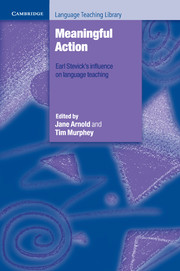Book contents
- Frontmatter
- Contents
- List of contributors
- Acknowledgements
- Preface
- Introduction
- Part A Meaning-making inside and between the people in the classroom
- Part B Meaningful classroom activity
- Part C Frameworks for meaningful language learning
- Epilogue: A way with words – perspectives on the contributions and influence of Earl W. Stevick
- Appendix: Words of tribute to Earl Stevick
- Index
Part B - Meaningful classroom activity
Published online by Cambridge University Press: 15 November 2023
- Frontmatter
- Contents
- List of contributors
- Acknowledgements
- Preface
- Introduction
- Part A Meaning-making inside and between the people in the classroom
- Part B Meaningful classroom activity
- Part C Frameworks for meaningful language learning
- Epilogue: A way with words – perspectives on the contributions and influence of Earl W. Stevick
- Appendix: Words of tribute to Earl Stevick
- Index
Summary
Our ultimate goal as language teachers is for our students to make meaning in our classrooms. The challenge for teachers is, of course, how to help them to do that most effectively. A key response to that challenge is constructing meaningful action in the language class. Kristjánsson (this volume) makes the important point that ‘Language is first of all a medium for communicating matters of relevance.’ From a Vygotskyan perspective, working with communication activities in the classroom would involve much more than speaking with grammatically correct sentences or giving information since, as Brooks and Donato (1994: 273) say, ‘through speaking, individuals maintain their individuality and create a shared social world’.
In the classroom, experiences that connect to learners’ lives and give them a greater sense of agency, of capacity to act, will inevitably have a better chance of turning linguistic information into productive acquisition of the language. The benefits of this type of classroom, however, are not only related to acquiring greater knowledge of the language. Engaging in meaningful learning where learners invest something of themselves can lead to self-growth and to individuals becoming more responsible participants in society. How can we encourage this? Fundamentally, teachers can create more meaningful classrooms through their interactions and relationships with learners and through the types of learning interventions they plan. Stevick (1976: 122) writes: ‘There is a point at which the teacher's whole personality makes an impact … where the teacher may try to supply missing motivation’, but he adds there is also a point at which ‘technique comes into its own, both for minimizing frustration and confusion, and for avoiding a feeling of stagnation in class activity’. He argues for ‘DEEPER AIMS in addition to the teaching of language’, something that might ‘“change your life” as contrasted with only “add to your language abilities”’ (Stevick 1998: 166).
Meaningfulness is a concern not only of learners, but also of teachers. In a meaningful classroom the teacher is also learning. As Underhill says (1999: 140–1), ‘my learning is about the group and its members including myself, now, moment by moment … Perhaps I even set a limit on the learning my students can do during a lesson by the amount of learning I am doing alongside them and at the same time.’
- Type
- Chapter
- Information
- Meaningful ActionEarl Stevick's Influence on Language Teaching, pp. 127 - 130Publisher: Cambridge University PressPrint publication year: 2013



